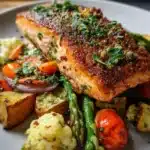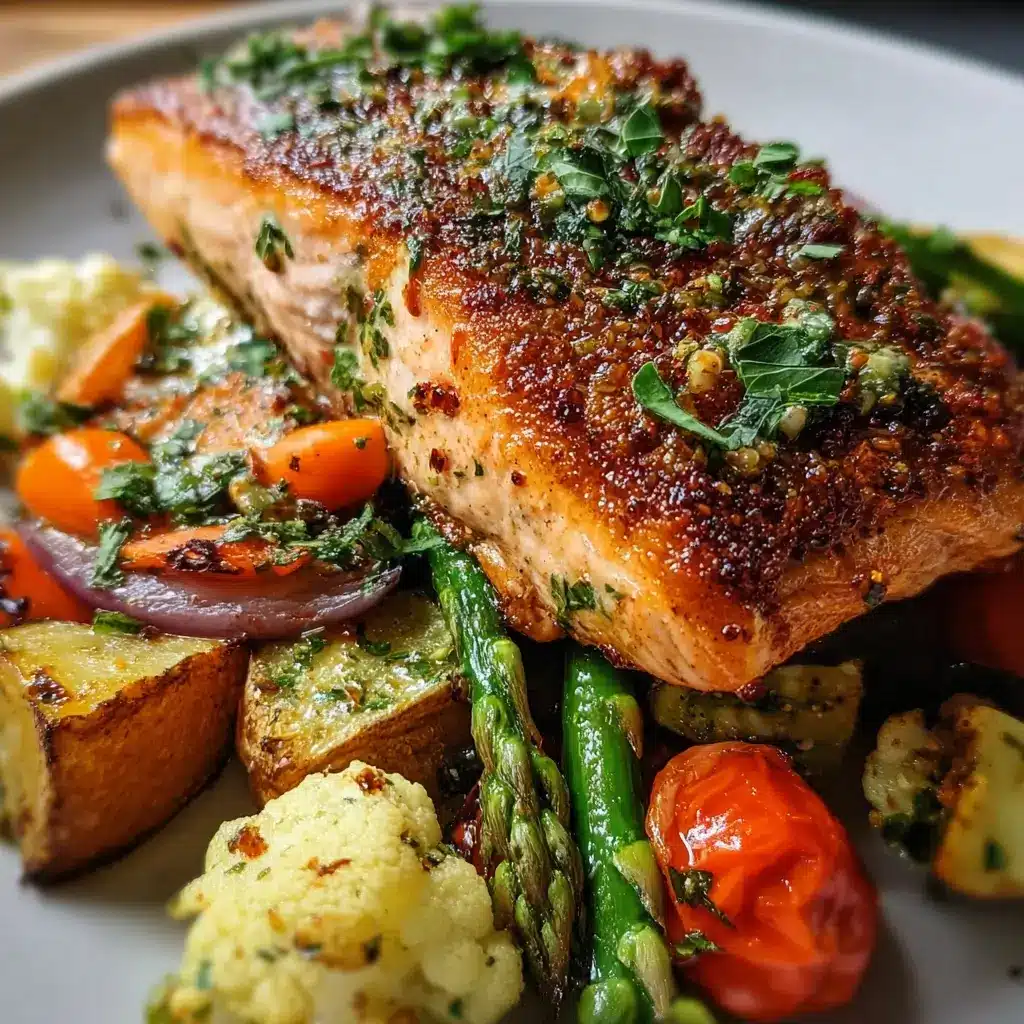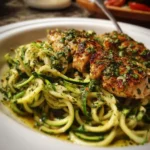Of all the dishes in my weekly rotation, this Crispy Salmon with Roasted Veggies has achieved legendary status in my household. It’s the meal I turn to on a chaotic Tuesday when I need something nourishing and quick, but it’s also elegant enough for a Saturday night dinner with friends. I’ll never forget the first time I truly perfected it. The kitchen filled with the incredible aroma of roasting garlic and lemon, but the real magic was the sound. That distinct, satisfying crackle as my fork broke through the salmon’s golden-brown skin, revealing the perfectly flaky, coral-pink flesh beneath. My kids, who are usually skeptical of anything green, were suddenly fighting over the caramelized broccoli florets and sweet, tender bell peppers. It was a moment of pure culinary victory. This isn’t just a recipe; it’s a solution. It’s the answer to “what’s for dinner?” that feels both incredibly wholesome and utterly indulgent. It’s proof that a healthy meal can be the most delicious one on the table, and the vibrant colors on the plate just make you feel good before you’ve even taken a bite.
Ingredients
This recipe is designed for simplicity and flavor, using fresh, accessible ingredients that come together to create a truly memorable meal. The ingredients are divided into three components: the salmon, the vegetables, and a simple yet elegant lemon-dill sauce to tie everything together.
For the Crispy Salmon:
- 4 (6-ounce) Salmon Fillets: Choose thick, center-cut fillets with the skin on. The skin is essential for achieving that signature crispiness, and the thickness ensures the fish remains moist and tender during cooking.
- 2 Tablespoons Olive Oil: A good quality extra-virgin olive oil not only prevents sticking but also adds a subtle, fruity flavor that complements the salmon beautifully.
- 1 Teaspoon Sea Salt: Coarse sea salt is preferred as it draws out moisture from the skin, which is a critical step for a crispy finish.
- ½ Teaspoon Black Pepper: Freshly ground black pepper provides a gentle heat and pungent aroma that elevates the overall flavor profile.
For the Roasted Vegetables:
- 1 Large Head of Broccoli: Cut into bite-sized florets. Broccoli roasts wonderfully, with the edges becoming delightfully crispy and the stems tender.
- 1 Red Bell Pepper: Cored, seeded, and sliced into strips. Bell peppers add a beautiful sweetness and vibrant color to the dish.
- 1 Red Onion: Cut into ½-inch wedges. When roasted, red onion becomes sweet and jammy, losing its raw pungency and adding a deep, savory flavor.
- 1 Pint Cherry Tomatoes: Left whole. These burst during roasting, releasing their sweet, tangy juices which create a natural sauce for the other vegetables.
- 4 Cloves Garlic: Lightly smashed but left in their skins. Roasting garlic this way infuses the entire dish with a mellow, sweet garlic flavor without the risk of burning.
- 3 Tablespoons Olive Oil: To coat the vegetables, ensuring they roast evenly and develop a beautiful caramelization.
- 1 Teaspoon Dried Oregano: Adds a classic, earthy Mediterranean flavor that pairs perfectly with both the vegetables and the salmon.
- Salt and Black Pepper: To taste, for seasoning the vegetables properly.
For the Lemon Dill Sauce:
- ½ Cup Greek Yogurt: Plain, full-fat Greek yogurt creates a creamy, tangy base for the sauce. Sour cream can also be used as a substitute.
- ¼ Cup Fresh Dill: Finely chopped. The fresh, slightly anise-like flavor of dill is a classic and unbeatable pairing for salmon.
- 1 Lemon: You will use the zest of the whole lemon and the juice of half. The zest provides intense lemon aroma, while the juice adds a bright, acidic kick.
- 1 Teaspoon Dijon Mustard: Adds a subtle tang and helps to emulsify the sauce, making it smooth and cohesive.
- A Pinch of Salt and Pepper: To balance the flavors of the sauce.
Instructions
Follow these step-by-step instructions carefully to ensure your vegetables are perfectly caramelized and your salmon skin is irresistibly crispy. The key is in the timing and the preparation technique.
Step 1: Preheat and Prepare the Pan
Begin by preheating your oven to 400°F (200°C). A high temperature is crucial for getting a good roast on the vegetables and a quick cook on the salmon. Place a large, rimmed baking sheet in the oven while it preheats. A hot pan helps the vegetables start sizzling the moment they touch the surface, preventing them from steaming and promoting better browning.
Step 2: Prepare the Vegetables
In a large mixing bowl, combine the broccoli florets, sliced red bell pepper, red onion wedges, whole cherry tomatoes, and the smashed garlic cloves. Drizzle with the 3 tablespoons of olive oil, and sprinkle with the dried oregano, salt, and pepper. Use your hands or a large spoon to toss everything together until the vegetables are evenly coated in oil and seasonings.
Step 3: Roast the Vegetables
Carefully remove the hot baking sheet from the oven. Spread the seasoned vegetables in a single, even layer across the pan. It is vital not to overcrowd the pan; if necessary, use two baking sheets. Crowding will cause the vegetables to steam instead of roast, and you won’t get those delicious crispy, caramelized edges. Place the baking sheet back in the oven and roast for 15 minutes.
Step 4: Prepare the Salmon
While the vegetables are in their initial roasting phase, prepare the salmon fillets. This is the most critical step for achieving crispy skin. Pat the skin of each salmon fillet completely dry with a paper towel. Moisture is the enemy of crispiness. Once dry, rub the flesh side and the skin side with the 2 tablespoons of olive oil, and season generously on all sides with sea salt and black pepper.
Step 5: Add the Salmon to the Pan
After the vegetables have roasted for 15 minutes, they should be starting to soften and brown at the edges. Carefully remove the baking sheet from the oven. Using a spatula, push the vegetables to the sides of the pan to create space in the center. Place the salmon fillets, skin-side up, in the cleared space on the pan. Arranging them skin-side up ensures the skin is exposed to the direct, dry heat of the oven.
Step 6: Finish Roasting
Return the baking sheet to the oven and continue to roast for another 10-15 minutes. The exact time will depend on the thickness of your salmon fillets. The salmon is cooked when it flakes easily with a fork and the internal temperature reaches 130-135°F (54-57°C) for medium. The skin should be golden brown and visibly crispy.
Step 7: Make the Lemon Dill Sauce
While the salmon and vegetables are finishing in the oven, whip up the quick sauce. In a small bowl, combine the Greek yogurt, chopped fresh dill, lemon zest, lemon juice, and Dijon mustard. Whisk everything together until smooth and creamy. Season with a pinch of salt and pepper to your liking.
Step 8: Rest and Serve
Once the salmon is cooked to perfection, remove the baking sheet from the oven. Let the salmon rest on the pan for 2-3 minutes. This allows the juices to redistribute throughout the fillet, resulting in a more tender and flavorful fish. Serve the crispy salmon fillets immediately alongside the roasted vegetables, with a generous dollop of the fresh lemon dill sauce on top or on the side.
Nutrition Facts
This dish is a powerhouse of nutrition, balancing lean protein, healthy fats, and fiber-rich vegetables.
- Servings: 4
- Calories Per Serving: Approximately 580 kcal
- High in Protein (Approx. 42g per serving): Salmon is an excellent source of high-quality protein, which is essential for building and repairing tissues, supporting muscle mass, and keeping you feeling full and satisfied.
- Rich in Omega-3 Fatty Acids (Approx. 2500mg per serving): Salmon is one of the best natural sources of Omega-3s (EPA and DHA), which are crucial for brain health, reducing inflammation, and supporting cardiovascular function.
- Excellent Source of Fiber (Approx. 8g per serving): The combination of broccoli, bell peppers, and onions provides a significant amount of dietary fiber, which aids in digestion, helps regulate blood sugar levels, and promotes a healthy gut microbiome.
- Packed with Vitamin C: The bell peppers and tomatoes are loaded with Vitamin C, a powerful antioxidant that supports the immune system, promotes healthy skin, and aids in iron absorption.
- Contains Healthy Monounsaturated Fats: The olive oil used for roasting is rich in monounsaturated fats, which are known to improve heart health by helping to reduce bad cholesterol levels (LDL) and increase good cholesterol levels (HDL).
Preparation Time
This recipe is designed to be efficient, making it a perfect choice for a busy weeknight meal without sacrificing flavor or quality.
- Preparation Time: 15 minutes
- Cooking Time: 25-30 minutes
- Total Time: 40-45 minutes
The preparation involves about 15 minutes of active work: chopping the vegetables, seasoning them, and preparing the salmon. The rest of the time is hands-off while the oven does all the work, giving you the perfect window to prepare the quick lemon dill sauce and set the table.
How to Serve
Presentation enhances the dining experience, and this colorful dish is easy to make look beautiful on the plate. Here are several ways to serve your Crispy Salmon with Roasted Veggies:
- Family-Style Platter:
- Arrange the vibrant roasted vegetables on a large platter to create a colorful bed.
- Carefully place the crispy salmon fillets on top, skin-side up, to showcase their golden-brown crust.
- Squeeze the juice from the remaining lemon half over the entire platter.
- Garnish with extra fresh dill fronds and a few twists of black pepper.
- Serve the lemon dill sauce in a small bowl on the side for everyone to help themselves.
- Individually Plated:
- For a more formal presentation, divide the roasted vegetables among four plates.
- Place one salmon fillet on top of or next to the vegetables on each plate.
- Drizzle a spoonful of the lemon dill sauce over the salmon, or create an elegant “swoosh” of sauce on the plate before adding the other components.
- Garnish with a lemon wedge on the side of each plate.
- With a Side Grain:
- To make the meal even more substantial, serve it with a healthy grain.
- Spoon a serving of fluffy quinoa, hearty brown rice, or pearled couscous onto each plate.
- Top the grain with a portion of the roasted vegetables and a crispy salmon fillet. This method is great for soaking up the delicious juices from the burst tomatoes and salmon.
- As a Hearty Salad Bowl:
- For a lighter, lunch-friendly option, serve the roasted vegetables and flaked salmon over a bed of fresh arugula or mixed greens.
- Drizzle with the lemon dill sauce, which doubles as a fantastic salad dressing.
- Toss gently to combine for a delicious and complete salad.
Additional Tips
Unlock the full potential of this recipe and customize it to your liking with these eight expert tips.
- The Ultimate Crispy Skin Secret: The key to shatteringly crisp skin lies in removing all moisture. After patting it dry with a paper towel, let the salmon sit uncovered in the refrigerator, skin-side up, for 20-30 minutes before cooking. This air-drying process wicks away even more surface moisture, guaranteeing an extra-crispy result.
- Choosing the Best Salmon: While any skin-on salmon works, different types offer different experiences. King (Chinook) salmon is rich and fatty, resulting in a buttery texture. Sockeye salmon is leaner and has a more intense flavor. Coho salmon is a great middle-ground. For the best results, look for fillets that are uniform in thickness to ensure even cooking.
- Vegetable Variations: Don’t be afraid to swap the vegetables based on season or preference. Asparagus spears, zucchini chunks, Brussels sprouts (halved), or sweet potato cubes are all fantastic for roasting. Just be mindful of cooking times—harder vegetables like sweet potatoes may need a few extra minutes in the oven before the salmon is added.
- The “No-Crowd” Rule: This is the golden rule of roasting. When vegetables are packed too tightly on a pan, they release steam, which gets trapped and essentially steams them instead of roasting them. Use two sheet pans if your vegetables don’t fit in a single, spacious layer. The extra dish to wash is well worth the superior flavor and texture.
- Perfecting Salmon Doneness: The best way to check for doneness is with an instant-read thermometer inserted into the thickest part of the fillet—aim for 130-135°F (54-57°C) for a moist, medium finish. If you don’t have a thermometer, use a fork to gently press on the thickest part. If the fish begins to separate into flakes easily, it’s ready. Remember it will continue to cook slightly from residual heat after being removed from the oven.
- Meal Prep and Make-Ahead Strategies: Save time on a busy night by prepping ahead. The vegetables can be chopped and stored in an airtight container in the refrigerator for up to 2 days. The lemon dill sauce can also be made a day in advance; just give it a good stir before serving as it may thicken slightly.
- Experiment with Sauces: While the lemon dill sauce is a classic, this salmon and veggie combo is a perfect canvas for other flavors. Try a zesty chimichurri, a simple pesto, a honey-mustard glaze (brushed on the salmon in the last 5 minutes of cooking), or a romesco sauce for a smoky, nutty alternative.
- Storing and Reheating Leftovers: Store leftover salmon and vegetables in an airtight container in the refrigerator for up to 2 days. The best way to reheat salmon without it becoming dry or rubbery is low and slow. Place it in a preheated oven at 275°F (135°C) for 10-15 minutes, until just warmed through. You can also flake the cold salmon over a salad for a delicious next-day lunch.
FAQ Section
Here are answers to some of the most common questions about making this Crispy Salmon with Roasted Veggies recipe.
1. Can I make this recipe with skinless salmon?
Absolutely. While you’ll miss out on the crispy skin texture, the dish will still be delicious. Simply season the skinless fillets and place them on the baking sheet. The cooking time will be roughly the same. You may want to place the fillets on a bed of lemon slices to prevent sticking and add extra flavor.
2. My salmon skin never gets crispy. What am I doing wrong?
The most common culprits are moisture and low heat. Ensure you are patting the skin exceptionally dry with paper towels. Seasoning with salt also helps draw out moisture. Second, make sure your oven is fully preheated to 400°F (200°C). Finally, placing the salmon skin-side up allows the direct heat to work its magic. Following these three steps should solve the problem.
3. Can I use frozen salmon for this recipe?
Yes, you can use frozen salmon, but it’s crucial to thaw it properly first. The best method is to transfer the frozen fillets from the freezer to the refrigerator and let them thaw overnight. Thawing this way ensures the texture of the fish remains intact. Once fully thawed, proceed with the recipe as written, making sure to pat the skin completely dry.
4. What other vegetables work well for roasting with salmon?
This recipe is very versatile. Great alternatives or additions include:
- Root Vegetables: Cubed sweet potatoes, carrots, or parsnips (note: these need a longer initial roasting time, so give them 20-25 minutes before adding the salmon).
- Cruciferous Vegetables: Brussels sprouts (halved) or cauliflower florets.
- Softer Vegetables: Asparagus spears or zucchini chunks (these cook faster, so you can add them to the pan at the same time as the salmon).
5. Is this recipe considered healthy?
Yes, this is an exceptionally healthy and well-balanced meal. It’s rich in lean protein, healthy omega-3 fatty acids, vitamins, minerals, and fiber. The use of olive oil provides healthy monounsaturated fats, and the roasting method requires minimal added fat compared to frying. It is naturally gluten-free and can easily be made dairy-free by using a dairy-free yogurt for the sauce.
6. How do I know when the vegetables are perfectly roasted?
Perfectly roasted vegetables will be tender on the inside with nicely browned, slightly crispy, and caramelized edges. They should not be mushy. The cherry tomatoes will have burst, and the onions will be soft and sweet. The initial 15-minute roast is key to giving them a head start before the salmon goes in.
7. Can I make this entire dish on a single sheet pan?
Yes, this recipe is designed as a one-pan meal, which is one of its biggest advantages. The key is to use a large enough sheet pan (a “half-sheet” size is ideal) so the ingredients can be spread out in a single layer. If you only have smaller pans, it’s better to use two pans to avoid overcrowding, which is the enemy of good roasting.
8. What is the best oil for high-heat roasting like this?
Olive oil is a great choice for this recipe as the 400°F (200°C) temperature is within its smoke point, and its flavor complements the Mediterranean profile of the dish. Other good oils with high smoke points include avocado oil (very neutral flavor), grapeseed oil, or sunflower oil.

Crispy Salmon with Roasted Veggies
Ingredients
This recipe is designed for simplicity and flavor, using fresh, accessible ingredients that come together to create a truly memorable meal. The ingredients are divided into three components: the salmon, the vegetables, and a simple yet elegant lemon-dill sauce to tie everything together.
For the Crispy Salmon:
- 4 (6-ounce) Salmon Fillets: Choose thick, center-cut fillets with the skin on. The skin is essential for achieving that signature crispiness, and the thickness ensures the fish remains moist and tender during cooking.
- 2 Tablespoons Olive Oil: A good quality extra-virgin olive oil not only prevents sticking but also adds a subtle, fruity flavor that complements the salmon beautifully.
- 1 Teaspoon Sea Salt: Coarse sea salt is preferred as it draws out moisture from the skin, which is a critical step for a crispy finish.
- ½ Teaspoon Black Pepper: Freshly ground black pepper provides a gentle heat and pungent aroma that elevates the overall flavor profile.
For the Roasted Vegetables:
- 1 Large Head of Broccoli: Cut into bite-sized florets. Broccoli roasts wonderfully, with the edges becoming delightfully crispy and the stems tender.
- 1 Red Bell Pepper: Cored, seeded, and sliced into strips. Bell peppers add a beautiful sweetness and vibrant color to the dish.
- 1 Red Onion: Cut into ½-inch wedges. When roasted, red onion becomes sweet and jammy, losing its raw pungency and adding a deep, savory flavor.
- 1 Pint Cherry Tomatoes: Left whole. These burst during roasting, releasing their sweet, tangy juices which create a natural sauce for the other vegetables.
- 4 Cloves Garlic: Lightly smashed but left in their skins. Roasting garlic this way infuses the entire dish with a mellow, sweet garlic flavor without the risk of burning.
- 3 Tablespoons Olive Oil: To coat the vegetables, ensuring they roast evenly and develop a beautiful caramelization.
- 1 Teaspoon Dried Oregano: Adds a classic, earthy Mediterranean flavor that pairs perfectly with both the vegetables and the salmon.
- Salt and Black Pepper: To taste, for seasoning the vegetables properly.
For the Lemon Dill Sauce:
- ½ Cup Greek Yogurt: Plain, full-fat Greek yogurt creates a creamy, tangy base for the sauce. Sour cream can also be used as a substitute.
- ¼ Cup Fresh Dill: Finely chopped. The fresh, slightly anise-like flavor of dill is a classic and unbeatable pairing for salmon.
- 1 Lemon: You will use the zest of the whole lemon and the juice of half. The zest provides intense lemon aroma, while the juice adds a bright, acidic kick.
- 1 Teaspoon Dijon Mustard: Adds a subtle tang and helps to emulsify the sauce, making it smooth and cohesive.
- A Pinch of Salt and Pepper: To balance the flavors of the sauce.
Instructions
Follow these step-by-step instructions carefully to ensure your vegetables are perfectly caramelized and your salmon skin is irresistibly crispy. The key is in the timing and the preparation technique.
Step 1: Preheat and Prepare the Pan
Begin by preheating your oven to 400°F (200°C). A high temperature is crucial for getting a good roast on the vegetables and a quick cook on the salmon. Place a large, rimmed baking sheet in the oven while it preheats. A hot pan helps the vegetables start sizzling the moment they touch the surface, preventing them from steaming and promoting better browning.
Step 2: Prepare the Vegetables
In a large mixing bowl, combine the broccoli florets, sliced red bell pepper, red onion wedges, whole cherry tomatoes, and the smashed garlic cloves. Drizzle with the 3 tablespoons of olive oil, and sprinkle with the dried oregano, salt, and pepper. Use your hands or a large spoon to toss everything together until the vegetables are evenly coated in oil and seasonings.
Step 3: Roast the Vegetables
Carefully remove the hot baking sheet from the oven. Spread the seasoned vegetables in a single, even layer across the pan. It is vital not to overcrowd the pan; if necessary, use two baking sheets. Crowding will cause the vegetables to steam instead of roast, and you won’t get those delicious crispy, caramelized edges. Place the baking sheet back in the oven and roast for 15 minutes.
Step 4: Prepare the Salmon
While the vegetables are in their initial roasting phase, prepare the salmon fillets. This is the most critical step for achieving crispy skin. Pat the skin of each salmon fillet completely dry with a paper towel. Moisture is the enemy of crispiness. Once dry, rub the flesh side and the skin side with the 2 tablespoons of olive oil, and season generously on all sides with sea salt and black pepper.
Step 5: Add the Salmon to the Pan
After the vegetables have roasted for 15 minutes, they should be starting to soften and brown at the edges. Carefully remove the baking sheet from the oven. Using a spatula, push the vegetables to the sides of the pan to create space in the center. Place the salmon fillets, skin-side up, in the cleared space on the pan. Arranging them skin-side up ensures the skin is exposed to the direct, dry heat of the oven.
Step 6: Finish Roasting
Return the baking sheet to the oven and continue to roast for another 10-15 minutes. The exact time will depend on the thickness of your salmon fillets. The salmon is cooked when it flakes easily with a fork and the internal temperature reaches 130-135°F (54-57°C) for medium. The skin should be golden brown and visibly crispy.
Step 7: Make the Lemon Dill Sauce
While the salmon and vegetables are finishing in the oven, whip up the quick sauce. In a small bowl, combine the Greek yogurt, chopped fresh dill, lemon zest, lemon juice, and Dijon mustard. Whisk everything together until smooth and creamy. Season with a pinch of salt and pepper to your liking.
Step 8: Rest and Serve
Once the salmon is cooked to perfection, remove the baking sheet from the oven. Let the salmon rest on the pan for 2-3 minutes. This allows the juices to redistribute throughout the fillet, resulting in a more tender and flavorful fish. Serve the crispy salmon fillets immediately alongside the roasted vegetables, with a generous dollop of the fresh lemon dill sauce on top or on the side.
Nutrition
- Serving Size: one normal portion
- Calories: 580
- Fiber: 8g
- Protein: 42g





